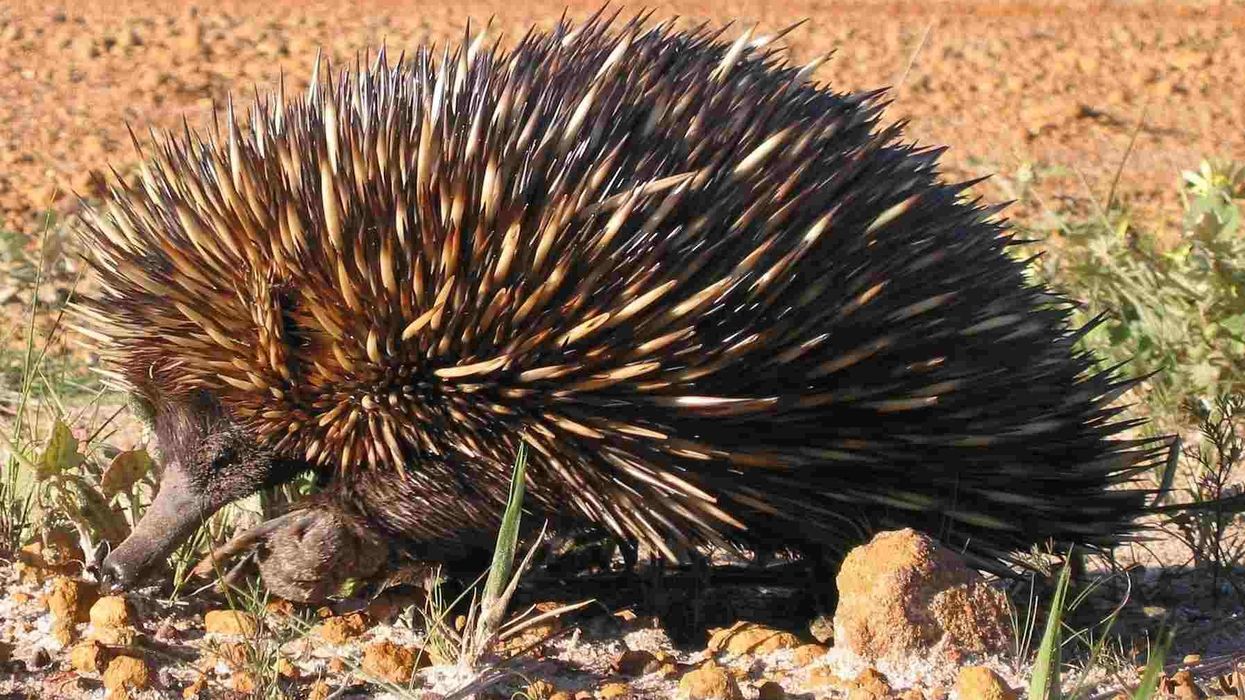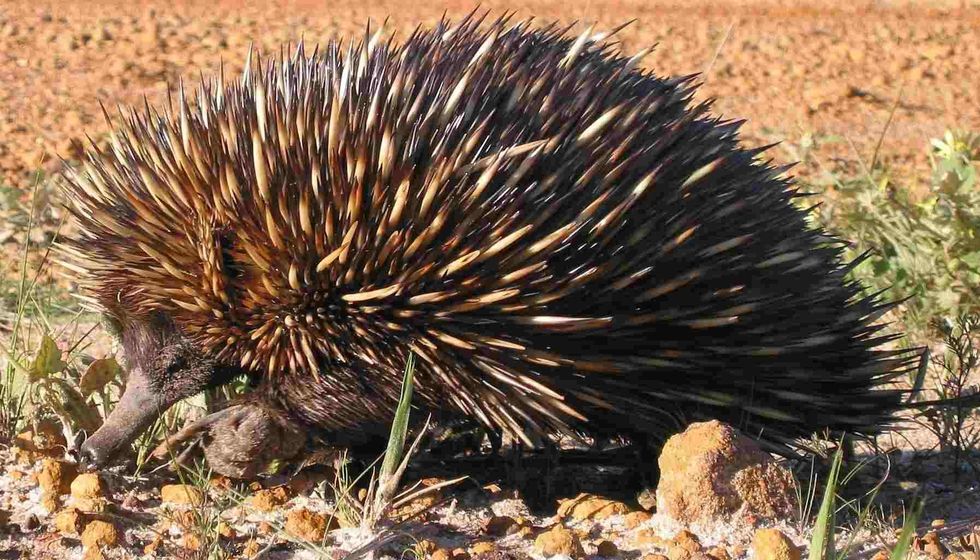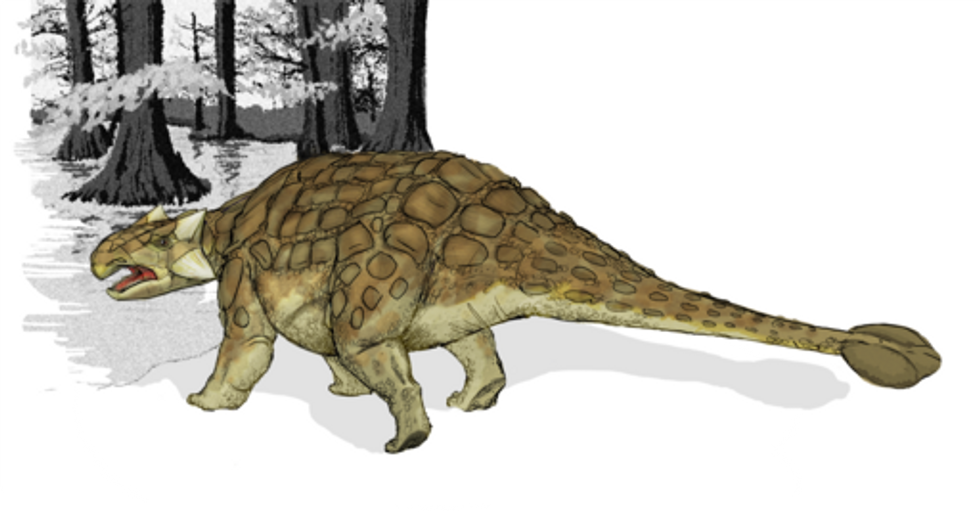The short beaked echidna (Tachyglossus aculeatus) is the sole member of the genus Tachyglossus, sharing the family of Tachyglossidae with species in New Guniea of the genus Zaglossus, which include the long beaked echidnas.
The scientific name 'Tachyglossus' means 'fast tongue' and the short beaked echidna belongs to the order Monotremata and is one of the four species of echidna. The short beaked echidna is a monotreme, which means that it belongs to mammals as it can lay eggs like the platypus.
Due to its eating habits involving using its snout and tongue to eat ants from anthills, and termite from fallen logs, they were previously called the spiny anteater, however, they have no relation to the original anteaters.
The short beaked echidna sometimes digs the earth, looking for beetles and earthworms in their surrounding environment. They are spread throughout Australia because they live in a wide range of places like urban environments, forests, and drylands, including the Tasmanian islands, making them the most common native mammal here.
They are also present in Eastern New Guinea where they are called 'mungwe'.
After winter, when the temperature slowly starts to rise, the activity of the short beaked echidna increases. Ideally, echidnas live and survive alone, but male and female echidnas meet once during the mating season, after which they part ways forever.
The female echidna lays one egg in a year. The leathery egg hatches and the baby is usually the size of a grape and is placed inside the mother's pouch. The mother's milk is highly nutritious which helps the baby to grow rapidly.
The young echidna grows spines in about seven weeks and then the mother releases it from its pouch. After six months, the young echidna leaves its mother, never to meet again.
The effect of the human population and foreign predators has reduced the distribution range of the beloved Australian short beaked echidna. Learn more about them here, or check out our guides to the leopard seal and fennec fox too!
Short Beaked Echidna Interesting Facts
What type of animal is a short beaked echidna?
Short beaked echidnas are mammals who lay eggs, along with the platypus, part of the monotremes order.
What class of animal does a short beaked echidna belong to?
The short beaked echidna belongs to the rare egg-laying Mammal class.
How many short beaked echidna are there in the world?
No study has been conducted to know the number of short beaked echidnas in the world, although it is believed that there are between 5 million and 50 million short beaked echidnas that are native to Australia and the Tasmanian Islands.
Where does a short beaked echidna live?
The short beaked echidna lives across a wide range of terrains including woodlands, savanna, semi-arid, arid, coastal, and highland areas.
What is a short beaked echidna's habitat?
A short beaked echidna prefers to live alone in the wild, digging soil with its claws to keep its eggs protected in a burrow. They cannot survive in warm conditions as they lack sweat glands to regulate their body temperature, and so depending on the weather they become nocturnal.
Who do short beaked echidna live with?
They live alone, wandering across large areas of the wild alone.
How long does a short beaked echidna live?
The average life span of a short beaked echidna is known to be 10 years, but they are capable of living well over 40 years. In captivity, it is recorded that they can live for up to 50 years!
How do they reproduce?
When it comes to the short beaked echidna's reproduction, their breeding season is between the months of May and September. During the breeding season, both male and female short beaked echidnas produce a strong odor.
Around 10 males follow a single female and the female chooses its preferred partner to mate from this group. After mating, the female lays a single egg. During the gestation period of 21 to 28 days, the female is busy creating a nursery burrow for her baby echidna.
Then, 10 days after laying the single soft-shelled leathery egg, it hatches. Young echidnas usually leave the burrow after a period of 12 months.
What is their conservation status?
As short beaked echidnas are quite common throughout Australia and New Guinea, they have a conservation status of Least Concern.
Short Beaked Echidna Fun Facts
What do short beaked echidnas look like?

Short beaked echidnas are normally black or brown in color and have a body that appears to merge with its head. With no external pinnae, instead, they just have ear holes on both sides.
They have tiny eyes, a wedge-shaped snout, a small mouth, and toothless jaws. They are known to use their snout and tongue effectively to feed themselves. Almost the entire body of the echidna is covered with spines.
Echidnas have spines that grow up to 2 in (6 cm) long that are in fact modified hairs and, contrary to popular belief, their quills are not poisonous. They also have very strong claws that help them dig up the soil with ease.
How cute are they?
Although their appearance at first might not strike us as a cute one with all the spikes covering its body, the short and tiny small beaked echidna, like many animals, can make you love them.
Even their response to threat can be found to be cute as they roll themselves up to a small ball of spikes, kinda cute right?
But, do be careful if you happen to find yourself around one, and don't pick up unless you are wearing thick protective gloves.
How do they communicate?
Short beaked echidna are found to communicate with their own by smell. During mating season, they rely on their odor to find their mate and the scent of their feces is an important means of communication. They also respond to threats by rolling up into a spiked ball, making use of their spiked exterior to deter any predators.
How big is a short beaked echidna?
Short beaked echidna are generally small creatures of the wild ranging from a length of 11-18 in (30-45 cm). They are not very tall off the ground and no scientific study has been conducted to study how tall they can grow.
Their small size when compared to their predators, like a dingo which are about three times the size of a short beaked echidna, would make them easy to prey on if it were not for their spikey exterior.
How fast can a short beaked echidna move?
They do not move very fast in their habitat, and it is observed that they may move around 1.42 miles per hour (2.3 km per hour). They do not require high speeds to survive.
How much does a short beaked echidna weigh?
A fully grown short beaked echidna can weigh up to 6-8 lb (3-3.5 kg), which is about half the weight of their cousin, the long beaked echidna.
What are their male and female names of the species?
There is not a specific name for female and male short beaked echidnas. These mammals are simply referred to as a male short beaked echidna or a female short beaked echidna.
What would you call a baby short beaked echidna?
A baby echidna is called by an extremely cute name, 'puggle'!
What do they eat?
Short beaked echidnas prey on ants, termites, beetles, and earthworms. As they do not have any teeth, these choices of insects make perfect sense. They use their long snouts to reach into nests and use their sticky tongues to pull in as many ants and termites as possible. These are then trapped on their backward-facing keratinous teeth.
Are they dangerous?
They are not considered dangerous as they do not fight against their predators. Remove their spiked exterior and they are just a rolled-up ball of fur!
Would they make a good pet?
Short beaked echidnas are extremely cute, but when you consider keeping one, due to their habits of digging, their need for a specific diet, and their long life span of up to 50 years, they are not pet material.
Did you know...
The short beaked echidna (Tachyglossus aculeatus) hibernates between February and April. Male short beaked echidnas end their hibernation in, mid-June and the female ends it during July or August. Interestingly, the non-reproductive female and the immature echidnas may not end their hibernation until October.
Their eyes have the characteristics of both a mammal and a reptile and, although they have poor eyesight, some believe them to be blind, but that is a common misconception.
Is the short beaked echidna endangered?
The short beaked echidna can be found all over Australia and New Guinea in high numbers. Their biggest threats are vehicles and the destruction of their habitat.
In fact, Australia's wildlife authorities have observed that over one-third of echidna deaths are caused by vehicles. One of their cousin species, the long beaked echidna, is even now extinct from the Australian continent.
Some of them also die due to various infections. Despite all this, due to their large number in existence, short beaked echidnas are not considered to be endangered and their conservation status as of now is Least Concern.
Different types of short beaked echidna
There is only one type of short beaked echidna in the world, and it it the one that you have now learnt all about!
Here at Kidadl, we have carefully created lots of interesting family-friendly animal facts for everyone to discover! Learn more about some other mammals including the tamandua, or the plains zebra.
You can even occupy yourself at home by drawing one on our short beaked echidna coloring pages.









